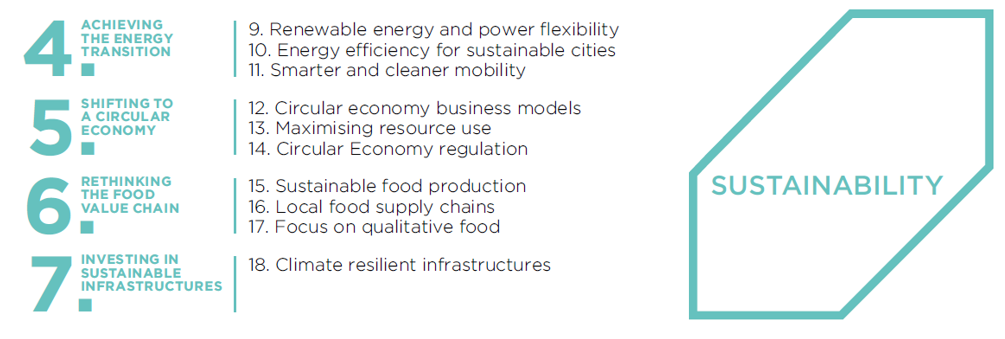 “Sustainability is obviously not a new topic – we have been debating it for years. However, the COVID-19 crisis has been a radical eye opener. There is a growing awareness that if we want the economic recovery to last over time, we cannot go back to environmentally destructive investment patterns and activities. To use the words of the OCDE, we need to ‘build back better’ in order to stand on more solid ground when the next crisis, which might well be one linked to the climate, comes.
“Sustainability is obviously not a new topic – we have been debating it for years. However, the COVID-19 crisis has been a radical eye opener. There is a growing awareness that if we want the economic recovery to last over time, we cannot go back to environmentally destructive investment patterns and activities. To use the words of the OCDE, we need to ‘build back better’ in order to stand on more solid ground when the next crisis, which might well be one linked to the climate, comes.
Many experts link this health crisis with the future climate crisis – which is expected to be much worse.
In view of this, the current crisis provides an opportunity to change and rebuild economies and societies that are much more sustainable. The political will is clearly there, as can be seen in the EU’s ‘Green Deal’ roadmap aimed at moving to a clean, circular economy, restoring biodiversity and cutting pollution.

One of the major trends that we identified for the coming years is the need to achieve an energy transition. Global supply chains have been severely shaken, and I think this was a strong reminder of how vulnerable our dependence on fossil fuel makes us. We are dependent on importing this energy source that is today indispensable, and, in addition, experts warn us that the supply will not last forever. Current projects suggest that the world may be on the cusp of its first true energy transition and move to more clean, renewable energy sources while also improving energy efficiency. However, more ambitious public policies are still needed.
The events of the recent months may also give an upswing to the circular economy as a means not only to protect the environment, but also to improve the use of resources and make society more resilient.
The difficulties to procure medical equipment at the early stages of the crisis clearly highlighted the vulnerability of our linear production model and dependence on global supply chains. People are now much more aware of the need for reusable masks or other medical equipment that can be disinfected and used again rather than just thrown away. The global market for refurbished medical devices is now expected to grow by over 10% per year between 2020 and 2025, a move that will reduce the need for new raw materials and create new market opportunities.
This is just one example that shows the relevance of the circular economy, but the same goes for many other economic sectors. Circular business models, such as product-as-a-service and the sharing economy, are emerging. However, the challenge remains for companies to develop models and production methods that are both sustainable and economically profitable.
Food production is another area where circular aspects are relevant. Once again, this is a field where the COVID-19 crisis highlighted the vulnerability of depending on global supply chains. On top of that, we know that current industrial agricultural models yield outputs of questionable quality, rely on fossil fuels and practices that are damaging to ecosystems, and require long-distancetransportation.
When the crisis hit, shopping patterns changed as people were looking to buy healthy, locally produced foodstuffs, and the demand for biological products exploded.
This provided an opportunity to experiment with shorter producer-consumer loops, for example by offering local products that were delivered to clients’ homes.
It is of course not realistic to expect that all food will be produced locally in the future, but I think that it has become clear that we need to encourage more regionalised, sustainable production models and solutions such as vertical farming. There is also a need for us as consumers to educate ourselves and better understand what products are really local and when they are in season.
Sustainability is also an important consideration for future infrastructure investments. Building publically financed infrastructure is a classical way of boosting the economy and creating jobs, and it will certainly be a key element of many relaunch plans. Numerous voices are now saying that such infrastructure must be sustainable, not only from an environmental perspective but also in view of a future climate crisis. Climate-resilient structures can contribute to reducing the economic damage of climate-related disasters and help decrease exposure and vulnerability.
The COVID-19 related lockdown gave us an insight into what a more sustainable society could look like.
The shut-down led to some widely reported environmental improvements, such as reduced emissions of greenhouse gases and air pollutants and less water pollutions. We know very well that once the economic activity is back to its previous level, the long-term impact will be almost zero, but nevertheless we got a simulation of how to drastically reduce our negative environmental footprint. This time, it happened at the price of the economy. The challenge for the future is to build economies where sustainability is part of the DNA.
I hope that we will remember the lessons from COVID-19 and let this be a starting point for building an economy that is sustainable, both for companies and for society as a whole.”

